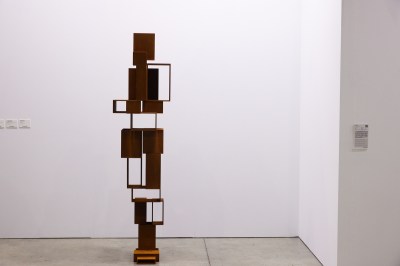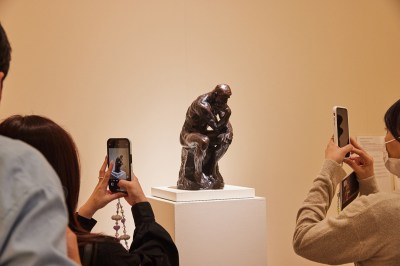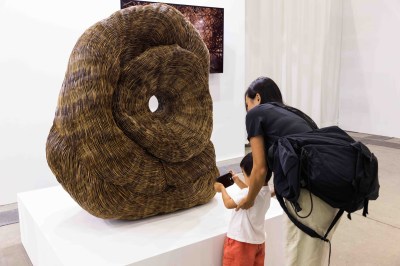Taipei Dangdai Art & Ideas, the Taiwan art fair, hosted its 2024 edition last week, with 78 dealers from 19 countries and territories exhibiting this year. The fair, now in its fifth edition, opened as Taiwan’s collectors continue to exhibit their purchasing power and the country’s leading art institutions flex their curatorial prowess to visiting international dealers, curators, and other art professionals.
The fair kicked off Thursday with a VIP opening during which blue-chip enterprise Galleria Continua reported selling a Corten-steel sculpture by Antony Gormley for over $625,000. By the fair’s end, several galleries participating for the first time reported positive sales results. Sydney-based Coma sold five out of six paintings by Australian-born, Santa Fe–based artist Justin Williams, with four selling at $31,000 each.
“In general, Taiwanese collectors are excited to discover new art,” Coma director Chengyang Yu told ARTnews. “The pace seems more subdued due to the emerging nature of the region compared to major art centers, but the enthusiasm is evident. There seems to be a healthy mix of interest in both regional and international art.”
Daudi Karungi, the founder of Ugandan gallery Afriart, sold several pieces from his artists during the fair and described the Taipei booth as “the busiest we have had in our art–fair history.”
Of those 78 dealers, 33 were participating for the first time, including Afriart, Coma, London’s Bowman Sculpture, Barcelona’s Polígrafa Obra Gràfica, and the Istanbul-based enterprises Dirimart and Zilberman. Around 25 percent of exhibitors were from Taiwan, 50 percent come from elsewhere in Asia, and 25 percent from the West. Returning blue-chip dealers included David Zwirner, Perrotin, Eric Firestone Gallery, and Galleria Continua.

An Antony Gormley sculpture at the 2024 edition of Taipei Dangdai.
Courtesy Taipei Dangdai
Those figures are slightly down from 2023, when 90 dealers participated. Fair co-director Robin Peckham, however, cautioned not to read too much into that shift, as Taipei Dangdai, and other fairs in Asia, are primarily working to serve their local scenes in a fine-tuned way.
“The entire Asian art market has become so complex that it was no longer being efficiently served by Hong Kong alone,” Peckham told ARTnews. “Collectors, artists, and arts professionals in every place have their own internal conversations, and that can’t always be fully reflected in one large hub.”
He continued, “By having fairs in different cities, we can go deeper into these markets and really serve the new collectors emerging from them. Taipei Dangdai is meant to play a role in parallel with all those other art destinations.”
With a history of collecting spanning two centuries, Taiwan’s long cultural heritage nurtures both artists and collectors. Today, the country, according to Peckham, is a collector-driven scene with typically open-minded taste and high purchasing power. For example, the 2023 UBS Global Wealth report ranked Taiwan as 12th in terms of median wealth per adult. While Hong Kong ranked third, other hyped regional art destinations like Korea, Singapore, and Japan fell below Taiwan, as did the US.
To mark Taiwan’s catastrophic 7.4-magnitude earthquake in April, which killed at least 10 and injured over 1,000, the fair co-curated a special group exhibition with the culture ministry, “Before Thunders: An Exhibition of Taiwanese Artists,” showcasing works focusing on island ecosystem, environment, and nature by artists from the quake epicenter in Hualien and beyond.

The scene at the 2024 edition of Taipei Dangdai.
Courtesy Taipei Dangdai
While Taiwanese artists continue to make strong work, it is a new phenomenon for local galleries to take on international projects. Historically, it has been the country’s top collectors, both private and corporate, that have brought exhibitions of international artists to Taiwan, via loans from their own collections, Peckham said. By comparison, he characterized China’s various art scenes as being spearheaded by some of its most famous artists, including Zeng Fanzhi, Yu Hong, and Liu Xiaodong.
During Taipei Dangdai, the country played host to numerous international exhibitions, including Asia University Museum of Modern Art’s current exhibition of 80-year-old Chinese artist Wang Huaiqing, a William Kentridge retrospective at the Taipei Fine Arts Museum, as well as a partnership between the Chimei Museum and London’s National Gallery that brought 52 works from the National Gallery’s collection, including pieces by Raphael, Titian, Caravaggio, Rembrandt, Van Gogh, and Monet, to Taipei. The Fubon Art Museum, designed by Renzo Piano, also had its grand opening this month, with its inaugural exhibitions being a collection show and one dedicated to Rodin and Impressionism.

A Rodin bronze sculpture at the 2024 edition of Taipei Dangdai.
Courtesy Taipei Dangdai
Meanwhile, international dealers deeply connected to the Asia-Pacific region continue to return to Taipei. Berlin’s Galerie Eigen + Art is participating in Taipei Dangdai for the third time, after hosting a pop-up in Taipei in 2021. For Eigen + Art, the continued engagement with the fair is as much about reaching European collectors, as it is Taiwanese ones.
“Since 2010, we have started to receive inquiries from European collectors for artists from China, Japan, Korea, Taiwan, Hong Kong, Singapore, or Indonesia. The mystical elements of Asian art pique the curiosity of European collectors,” Shao-Yi Hou, a senior director at the gallery, told ARTnews.
Catering to Asian collectors at a fair like Taipei Dangdai requires one to be attuned to their tastes. According to Hou, Asian collectors often go for the German artist Neo Rauch and his students, among them Kristina Schuldt.
“While Asian collectors have less direct interactions with European artists, they take more time to assess the quality and consistency of the artists, as well as their potential value in the secondary market, whereas European collectors tend to follow their intuitions and make decisions quickly,” Hou said.

Taipei Dangdai cofounder Magnus Renfrew (right) stands with Taipei mayor Chiang Wan-an looking at an artwork, at the 2024 edition of Taipei Dangdai.
Courtesy Taipei Dangdai
Taipei Dangdai, and Taiwan in general, is also being increasingly host to galleries hailing from Africa, like Afriart. Karungi, the gallery’s founder, said Taiwan is a good fit for his business, as the market is sophisticated, yet less exposed to African art compared to Hong Kong.
“In the past four decades, Uganda experienced a respite from civil wars and entered a period of relative stability,” he said. “People could begin to transition from fighting merely for survival to affording art appreciation and creation. Yet in most sub-Sahara countries, a collector base is virtually nonexistent with the exception of the continent’s largest economies, like South Africa, Nigeria, and Morocco.”
He continued, “Beyond Africa, African artists tend to raise visibility in leading art centers in Europe and the US, but curators from the Western world tend to scour for talents from the African diaspora already living in European capitals and make less efforts to dive deep inside the continent to discover promising artists. We need to go out to the world and be seen.”
Beyond sales, Karungi said he hopes to use Taipei Dangdai as a launching pad to connect with Taiwanese curators and sponsors in the hopes of pushing forward large-scale museum exhibitions showcasing African art in Taiwan and elsewhere in Asia.

The scene at the 2024 edition of Taipei Dangdai.
Courtesy Taipei Dangdai
Afriart and other international galleries at Taipei Dangdai are entering the market as Taiwan reaches an inflection point, according to Peckham. Taiwan’s top collectors, who typically worked within the secondary market and auction system, are now in their 70s or 80s. A younger generation of collectors with international tastes is gaining momentum. That new generation is more active on the primary market.
China is currently suffering an economic slump due to slowing foreign demand for Chinese products and a major downturn in the country’s real estate market. Meanwhile, Hong Kong’s legislature passed a new sweeping national security law that has left some in the art world wary of negative impacts on the art markets in the Chinese-speaking world, including Taiwan’s.
Peckham dismissed such concerns, noting that while wealthy Taiwanese people often run tech or manufacturing companies in China, they are not overly involved in the real estate or stock markets there; many are, in fact, more tied to the US market, leaving them somewhat insulated to Chinese economic concerns. Many collectors, he went on, are shrewd in their dealings with China, taking advantage of a weaker Chinese market to buy up assets at lower prices.
“In a lot of ways, it’s actually a good moment for Taiwanese collectors,” he said.
This post was originally published on this site be sure to check out more of their content





